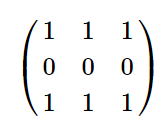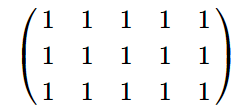Preparando MOJI
You are given an array $$$a$$$ of length $$$n$$$ and array $$$b$$$ of length $$$m$$$ both consisting of only integers $$$0$$$ and $$$1$$$. Consider a matrix $$$c$$$ of size $$$n \times m$$$ formed by following rule: $$$c_{i, j} = a_i \cdot b_j$$$ (i.e. $$$a_i$$$ multiplied by $$$b_j$$$). It's easy to see that $$$c$$$ consists of only zeroes and ones too.
How many subrectangles of size (area) $$$k$$$ consisting only of ones are there in $$$c$$$?
A subrectangle is an intersection of a consecutive (subsequent) segment of rows and a consecutive (subsequent) segment of columns. I.e. consider four integers $$$x_1, x_2, y_1, y_2$$$ ($$$1 \le x_1 \le x_2 \le n$$$, $$$1 \le y_1 \le y_2 \le m$$$) a subrectangle $$$c[x_1 \dots x_2][y_1 \dots y_2]$$$ is an intersection of the rows $$$x_1, x_1+1, x_1+2, \dots, x_2$$$ and the columns $$$y_1, y_1+1, y_1+2, \dots, y_2$$$.
The size (area) of a subrectangle is the total number of cells in it.
The first line contains three integers $$$n$$$, $$$m$$$ and $$$k$$$ ($$$1 \leq n, m \leq 40\,000, 1 \leq k \leq n \cdot m$$$), length of array $$$a$$$, length of array $$$b$$$ and required size of subrectangles.
The second line contains $$$n$$$ integers $$$a_1, a_2, \ldots, a_n$$$ ($$$0 \leq a_i \leq 1$$$), elements of $$$a$$$.
The third line contains $$$m$$$ integers $$$b_1, b_2, \ldots, b_m$$$ ($$$0 \leq b_i \leq 1$$$), elements of $$$b$$$.
Output single integer — the number of subrectangles of $$$c$$$ with size (area) $$$k$$$ consisting only of ones.
3 3 2 1 0 1 1 1 1
4
3 5 4 1 1 1 1 1 1 1 1
14
In first example matrix $$$c$$$ is:

There are $$$4$$$ subrectangles of size $$$2$$$ consisting of only ones in it:

In second example matrix $$$c$$$ is:
